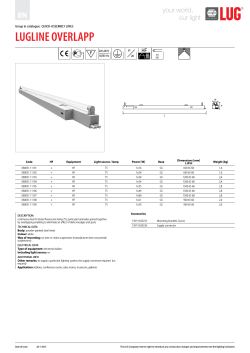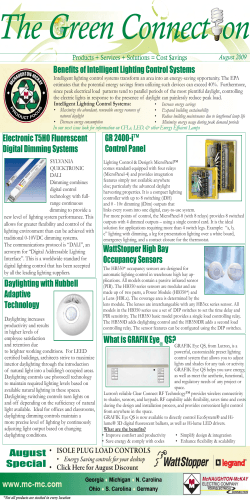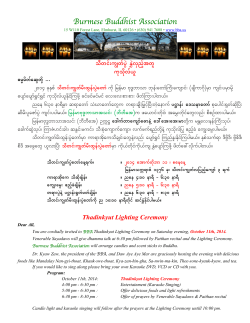
Module 3: Indoor Lighting Controls Mandatory Measures
MANDATORY MEASURES INDOOR LIGHTING CONTROLS (Reference: Sub-Chapter 4, Section 130.1) MANDATORY LIGHTING CONTROLS 1. 130.1 (a) Area Controls: Manual controls that control lighting in each area separately 2. 130.1 (b) Multi-level Controls: “Dimmability.” Allow occupants to choose the appropriate light level for each area 3. 130.1 (c) Shut-off Controls: Automatically shut off lighting or reduce light levels when illumination is not needed 4. 130.1 (d) Automatic Daylighting Controls: Adjust electric lighting in response to the presence of daylight 5. 130.1 (e) Automated Demand Response: Receive and automatically respond to demand response (DR) signals Section 130.1 4/22/2015 SLIDE 46 SECTION 3 INDOOR CONTROLS MANUAL ON/OFF CONTROLS An “area” is a space enclosed by ceiling-height partitions. All lighting in each area must be controlled separately from luminaires in other areas by manual on/off lighting controls that are: 1. Readily accessible 2. Located in the same room or area as the lighting they control and with the lighting in view 3. Able to provide any required dimming or multi-level controls steps in addition to on/off Section 100.1 4/22/2015 SLIDE 47 SECTION 3 INDOOR CONTROLS PUBLIC RESTROOMS Any public restroom with two or more stalls may use a manual switch that is not accessible to unauthorized personnel. All other lighting controls are still required. Section 130.1 (a)2 4/22/2015 SLIDE 48 SECTION 3 INDOOR CONTROLS EGRESS LIGHTING Reduced exception for egress lighting 2008: 0.3 W/ft2 anywhere 2013: Maximum security and egress lighting allowance of 0.2 W/ft2 when a building is occupied • General and egress lighting must be shut off during unoccupied times • Exception: Offices are allowed up to 0.05 W / ft2 for lighting during unoccupied periods, but only along emergency egress areas designated on the building plans Section 130.1 (a) 4/22/2015 SLIDE 49 SECTION 3 INDOOR CONTROLS MULTI-LEVEL LIGHTING CONTROLS Title 24 sets a minimum number of control steps and illuminance uniformity requirements for most major luminaire types (see TABLE 130.1-A). These requirements are required in addition to any mandatory manual, daylight, shut-off, or demand response controls. The criteria in 130.1 (b) applies to general lighting for enclosed areas that: • Are at least 100 ft2 in size • Have a connected lighting load over 0.5 W/ft2 • Have more than one luminaire or more than two lamps • Controlled lighting in daylit zones over 0.3 W/ft2 Section 130.1 (b) 4/22/2015 SLIDE 50 SECTION 3 INDOOR CONTROLS MULTI-LEVEL LIGHTING CONTROLS Each luminaire must meet the multi-level control requirements. Controlling alternating luminaires or rows of luminaires does not meet the requirements. 50% Power Section 130.1 (b) 100% Power 4/22/2015 SLIDE 51 SECTION 3 INDOOR CONTROLS TABLE 130.1-A Section 130.1, page 138 4/22/2015 SLIDE 52 SECTION 3 INDOOR CONTROLS MULTI-LEVEL LIGHTING CONTROLS In addition to meeting the dimmability requirements, each luminaire must also be controlled with one of the following strategies: • Manual dimming • Lumen maintenance • Tuning • Automatic daylighting • Demand response Section 130.1 (b) 4/22/2015 SLIDE 53 SECTION 3 INDOOR CONTROLS AUTOMATIC SHUT-OFF CONTROLS Automatic shut-off controls turn lights off when a space is unoccupied. All lighting must be controlled by one or more of the following: 1. Occupant sensing control 2. Automatic time-switch 3. Building Energy Management System 4. Other control mechanism capable of automatically shutting off all lights for vacant periods A single control may not monitor more than 5,000 ft2 Photo: Lutron Section 130.1 (c) 4/22/2015 SLIDE 54 SECTION 3 INDOOR CONTROLS AUTOMATIC SHUT-OFF CONTROLS In the following spaces, shut-off controls MUST be occupancy sensing: 1. Offices 250 ft2 or smaller 2. Multipurpose rooms smaller than 1,000 ft2 3. Conference rooms of any size 4. Classrooms of any size Section 130.1 (c) 4/22/2015 SLIDE 55 SECTION 3 INDOOR CONTROLS AUTOMATIC SHUT-OFF CONTROLS Countdown timer switches may only be used in: 1. Single-stall bathrooms smaller than 70 ft2 2. Closets smaller than 70 ft2 3. Server rooms smaller than 500 ft2 If time-based controls are used, occupants there after hours must be able to activate lighting as needed: • Manual switch • Temporary override • Occupancy-based control Section 130.1 (c) 4/22/2015 SLIDE 56 SECTION 3 INDOOR CONTROLS AUTOMATIC SHUT-OFF CONTROLS Adaptive controls in secondary spaces Controls for lighting in corridors and stairwells must be capable of: • Partially reducing lighting power during hours of operation in addition to • Providing full shut-off functionality when the building is vacant. Section 130.1 (c) 4/22/2015 SLIDE 57 SECTION 3 INDOOR CONTROLS AUTOMATIC SHUT-OFF CONTROLS Corridors and stairwells • Sensors/controls should be activated from all potential entrances • Minimum automatic 50% reduction in lighting power when vacant • Exceptions for hospitality and residential applications Photo: Cree, Inc. Section 130.1 (c) 4/22/2015 SLIDE 58 SECTION 3 INDOOR CONTROLS MIXED-USE BUILDINGS For mixed-use buildings (e.g. high-rise residential, hotels, and motels) with a total interior common area that is greater than 20 percent of the floor area of that building, the common areas must comply with the Nonresidential Lighting Standards, while dwelling units must comply with the Residential Lighting Standards. Photo: UC Davis 4/22/2015 SLIDE 59 SECTION 3 INDOOR CONTROLS CASE STUDY: ADAPTIVE CORRIDOR LIGHTING Bainer Hall, UC Davis (Davis, CA) • Research conducted in spring 2011 • CLTC replaced or retrofit 4-lamp T8 fluorescent luminaires with three adaptive corridor lighting solutions from different manufacturers • Average energy savings: 73% (based on an average occupancy rate of 18%) 4/22/2015 SLIDE 60 SECTION 3 INDOOR CONTROLS CASE STUDY: ADAPTIVE CORRIDOR LIGHTING Latham Square (Oakland, CA) • In January 2012, CLTC installed adaptive (bi-level) lighting controls on 12 floors of the Latham Square office building • 174 Luminaires retrofitted with 64W T8 fluorescents • Average energy savings: 86% • Cost savings over five-years: $23,803 4/22/2015 SLIDE 61 SECTION 3 INDOOR CONTROLS AUTOMATIC SHUT-OFF CONTROLS Spaces that are exempt from automatic shut-off controls requirements: 1. Buildings with lighting in continuous use 24 hours/day, 365 days/year 2. Areas where partial on/off controls are required instead of shut-off controls (such as stairwells and corridors) 3. Electrical equipment rooms 4. Emergency egress lighting Section 130.1 (c) 4/22/2015 SLIDE 62 SECTION 3 INDOOR CONTROLS AUTOMATIC DAYLIGHTING CONTROLS Automatic daylight controls adjust electric lighting power when ample daylight is available. “Ample daylight” is defined by the standards as 150% of the designed light level for electric lighting. Automatic daylighting controls are required for luminaires that: Photo: Lutron 1. Provide general lighting 2. Are at least half in a skylit or sidelit area 3. Are in an area where the total installed general lighting power is at least 120 watts 4. Are located in an area which has at least 24 ft2 of glazing Photo: Lutron Section 130.1 (d) 4/22/2015 SLIDE 63 SECTION 3 INDOOR CONTROLS AUTOMATIC DAYLIGHTING CONTROLS Automatic daylighting controls requirements: 1. Controlled lighting with an LPD greater than 0.3 W/ft2 must have multi-level lighting in accordance with Table 130.1-A. 2. Controlled lighting + daylight must equal or exceed the controlled electric lighting level without daylight. 3. When there is ample daylight detected, the general lighting power in that space must be reduced by at least 65%. Section 130.1 (d) 4/22/2015 SLIDE 64 SECTION 3 INDOOR CONTROLS CASE STUDY: DAYLIGHTING / INTEGRATED OFFICE LIGHTING California National Guard Joint Force Headquarters (Sacramento, California) • In the open office area, recessed T8 fluorescents were replaced with indirect/direct pendant luminaires • Integrated photosensors in luminaires along west and north perimeters • Ceiling-mounted zonal occupancy sensors • LED undercabinet and desktop task lighting (6W or 9W) • Annual energy savings: 50% or 16,400 kWh • Annual cost savings: $2,100 4/22/2015 SLIDE 65 Integrated Office Lighting System (IOLS) with luminaire-integrated photosensors along perimeters and occupancy sensors for ambient and task lighting SECTION 3 INDOOR CONTROLS DEMAND RESPONSE When the demand for electricity threatens to exceed supply, the power grid becomes less stable and the risk of outages increases. Demand response (DR) programs allow end users to temporarily reduce their electricity use in response to a notice or automated signal sent from a utility, independent system operator (ISO) or other power provider. This flexibility helps reduce peak demand and maintain grid stability. Currently, participating customers also receive financial incentives. Image: Lutron Section 130.1 (e) 4/22/2015 SLIDE 66 SECTION 3 INDOOR CONTROLS DEMAND RESPONSE How DR Works In traditional, non-automated DR programs, a local service provider sends notification of a pending DR event to facility managers, via e-mail, phone call or text message, requesting a reduction in electricity consumption for a limited period of time. Auto DR Automated demand response (ADR) programs make use of energy management technologies and controls to respond to DR events more quickly and reliably. The provider issues an automated DR signal to energy management control systems enrolled in ADR programs. The systems then automatically respond by reducing electricity use according to pre-programmed load shed strategies. Section 130.1 (e) 4/22/2015 SLIDE 67 SECTION 3 INDOOR CONTROLS DEMAND RESPONSE Lighting is extremely well-suited to DR 1. Peak demand periods typically overlap daylight hours 2. Research indicates illuminance levels can be reduced by as much as 20% without occupants detecting the change 3. Light levels can be immediately restored when DR events end Buildings larger than 10,000 ft2 must be capable of responding to a DR signal by automatically reducing lighting power at least 15% below the total installed lighting power while maintaining the uniformity requirements listed in Table 130.1-A. Spaces that use less than 0.5 W/ft2 and non-habitable spaces, such as storage closets, are exempt and cannot be counted toward ADR compliance. Section 130.1 (e) 4/22/2015 SLIDE 68 SECTION 3 INDOOR CONTROLS DEMAND RESPONSE What is a DR-capable system? A DR system reduces electricity demand in response to a notice or automated signal from utilities, independent system operators or other power providers. Manual DR • Requires occupant to manually adjust lighting systems in response to a phone call, e-mail, system notification, etc. Automatic DR • The removal of human interaction from the process allows faster reaction to DR events. • An electronic DR message will be broadcasted to energy management control systems when an electricity grid experiences high period of high demand or limited supply. 4/22/2015 SLIDE 69 SECTION 3 INDOOR CONTROLS DEMAND REPONSE DEVICES 4/22/2015 SLIDE 70 SECTION 3 INDOOR CONTROLS CHECK YOUR UNDERSTANDING: DEMAND RESPONSE An 80,000 ft2 building is being constructed. It will contain 10 tenant spaces, each 8,000 ft2 in size. Do these tenant spaces need to comply with the requirements for automatic demand response? 4/22/2015 SLIDE 71 SECTION 3 INDOOR CONTROLS CASE STUDY: ADAPTIVE CORRIDOR UCSF Mount Zion Medical Center • In 2013 SPEED installed three different lighting control systems in 3 separate corridors of the UCSF Medical Center • Total: 50 two-lamp T8 fluorescent fixtures • Bi-Level occupancy based dimming between 20% (Low Mode) and 70% (High Mode) on 50 2-Lamp T8 fixtures • Energy and CO2E Savings: 53-68% 4/22/2015 SLIDE 72 SECTION 3 INDOOR CONTROLS CASE STUDY: LIGHTING TECHNOLOGY SHOWCASE UCSB LED Retrofit • Student Information Systems and Technology office • Three open office spaces with cubicles • 58 2’x2’ 56W recessed fluorescent replaced by 58 dimmable LED • Monitored from May to October 2013 • Occupancy rate: 28% • Reduced energy use by 89% • Annual energy savings estimate: 11,500 kWh • Lifetime energy cost savings: $315 per fixture based on UCSB rate of $0.11/kWh Images: Enlighted 4/22/2015 SLIDE 73 SECTION 3 INDOOR CONTROLS SUMMARY OF MANDATORY LIGHTING CONTROLS DISCUSSION: What types of controls will office spaces typically require? 1. Manual controls What needs to be switched separately? 2. Automatic shut-off controls Where are they required? 3. Automatic daylighting controls Which lighting systems must comply? 4. ADR When a signal is received, what should occur? 4/22/2015 SLIDE 74 SECTION 3 INDOOR CONTROLS PARKING GARAGES Parking garages are considered interior nonresidential spaces, except for the top level of each multi-tier garage. • General lighting must have occupant sensing controls with at least one control step between 20% and 50% of design lighting power • No more than 500 watts of rated lighting power may be controlled together • Parking garage areas with at least 36 ft2 of glazing or opening must have automatic daylighting controls Photo: Lithonia Lighting Section 130.1 (c)7B 4/22/2015 SLIDE 75 SECTION 3 OUTDOOR LIGHTING DAYLIGHT CONTROLS EXEMPTIONS IN PARKING GARAGES Luminaires in the following areas do not need to use photocontrols: Daylight transition zone: The pathway vehicles use to enter a parking garage. Dedicated ramps: Driveways specifically meant to move vehicles between the floors of a parking garage and which have no adjacent parking. Some sidelit zones: If the primary sidelit zone uses less than 60W of lighting power, the combined primary and secondary sidelit zones do not require daylight controls. Section 130.1 (c)7B 4/22/2015 SLIDE 76 SECTION 3 OUTDOOR LIGHTING CASE STUDY: SAN MARCOS CIVIC CENTER PARKING GARAGE 4/22/2015 SLIDE 77 SECTION 3 OUTDOOR LIGHTING
© Copyright 2025









